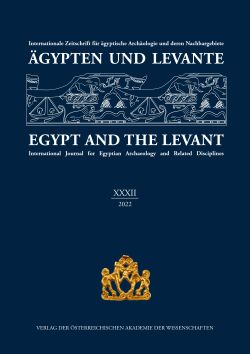Filip Taterka
S. 373 - 391
doi:
10.1553/AEundL32s373
Verlag der Österreichischen Akademie der Wissenschaften
doi:
10.1553/AEundL32s373
Abstract:
The aim of this article is to re-analyse an inscription about a royal elephant hunt in the land of Niyi, carved on the west wall of the Punt Portico in the temple of Hatshepsut at Deir el- Bahari. A re-examination and new collation of the original text led to the conclusion that the inscription was a later addition, whose insertion required a modification of the original decoration of this section of the wall. The author observed that, contrary to the generally accepted view of scholars, the cartouche in the first column of the inscription does not include Thutmose I’s throne name but rather that of Hatshepsut, which was subsequently changed to Thutmose II’s. This article also discusses the historical ramifications of the abovedescribed reconstruction of the creation process and the subsequent modification of the inscription in question.
Niyi, elephant hunt, Hatshepsut, Thutmose I, temple of Hatshepsut, Punt Portico
Published Online:
2023/02/08 07:05:56
Object Identifier:
0xc1aa5576 0x003e0a73
Rights:All rights reserved.For questions regarding copyright and copies please contact us by email.
Die Zeitschrift Ägypten und Levante wurde im Jahr 1990 von Manfred Bietak begründet, um den Forschungen zu den Kulturkontakten zwischen Ägypten und seinen Nachbarländern sowie der ägyptisch-kanaanäischen Hybridkultur, wie sie vor allem bei den österreichischen Ausgrabungen in Tell el-Dab’a zutage trat, eine Publikationsplattform zu bieten. Von Anfang an war die Zeitschrift international und interdisziplinär ausgerichtet. Das Themenfeld geht über die ursprüngliche Kernthematik weit hinaus und umfasst sowohl Vorberichte und Berichte zu archäologischen Grabungen in Ägypten und dem gesamten Vorderen Orient sowie Nubien und dem Sudan, wie auch Artikel zu allen Aspekten der ägyptischen und nahöstlichen Archäologie, Geschichts- und Kulturwissenschaft. Der Fokus liegt auf der pharaonischen Zeit, jedoch sind sowohl Beiträge zur Ur- und Frühgeschichte der genannten Regionen wie auch zur nachpharaonischen Antike möglich. Dazu wird ein weites Feld an naturwissenschaftlichen Themen abgedeckt, von Fragen der C14-Datierung über materialkundliche Untersuchungen bis hin zu archäobotanischen, archäozoologischen und anthropologischen Arbeiten.
Ägypten und Levante erscheint einmal jährlich im Druck und online. Die Redaktion ist bemüht, eingereichte Artikel möglichst zeitnah zu publizieren. Beiträge sind in Deutsch, Englisch oder Französisch einzureichen. Buchbesprechungen und Rezensionen werden nicht publiziert. Alle eingereichten Artikel werden einem internationalen peer-review Verfahren gemäß den Qualitätsstandards der Österreichischen Akademie der Wissenschaften unterzogen.
Egypt and the Levant was founded by Manfred Bietak in 1990 to provide a publication platform for the research on cultural contacts between Egypt and her neighbours. A focus of interest was the Egyptian-Canaanite fusion of cultures, which was mainly encountered at the site of Tell el-Dab’a during the Austrian excavations. From the beginning, the scope of the journal was international and interdisciplinary. The subject area has now been greatly expanded far beyond the original topics. It comprises reports and preliminary reports on archaeological excavations in Egypt and the entire Middle East including the Sudan, as well as articles dealing with all aspects of Egyptian and Near Eastern archaeology, history or cultural history. The main emphasis lays on the pharaonic period, but both contributions to prehistory of the said regions, and post-pharaonic periods may be accepted. In addition, a broad range of scientific topics is covered, including C14-dating, material analyses, archaeobotanical and archaeozoological studies as well as studies in physical anthropology.
Egypt and the Levant is published on an annual basis, both in print and online. Submitted articles are intended to be published in a timely manner. Manuscripts may be submitted in English, German or French. Book reviews are not accepted. All submitted articles are subject to international peer-review according to quality standards of the Austrian Academy of Sciences.



 Home
Home Print
Print
 References
References
 Share
Share
